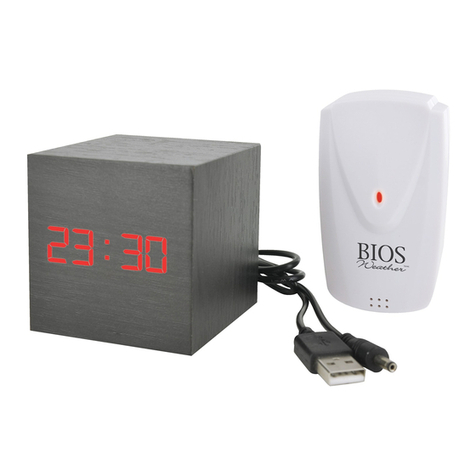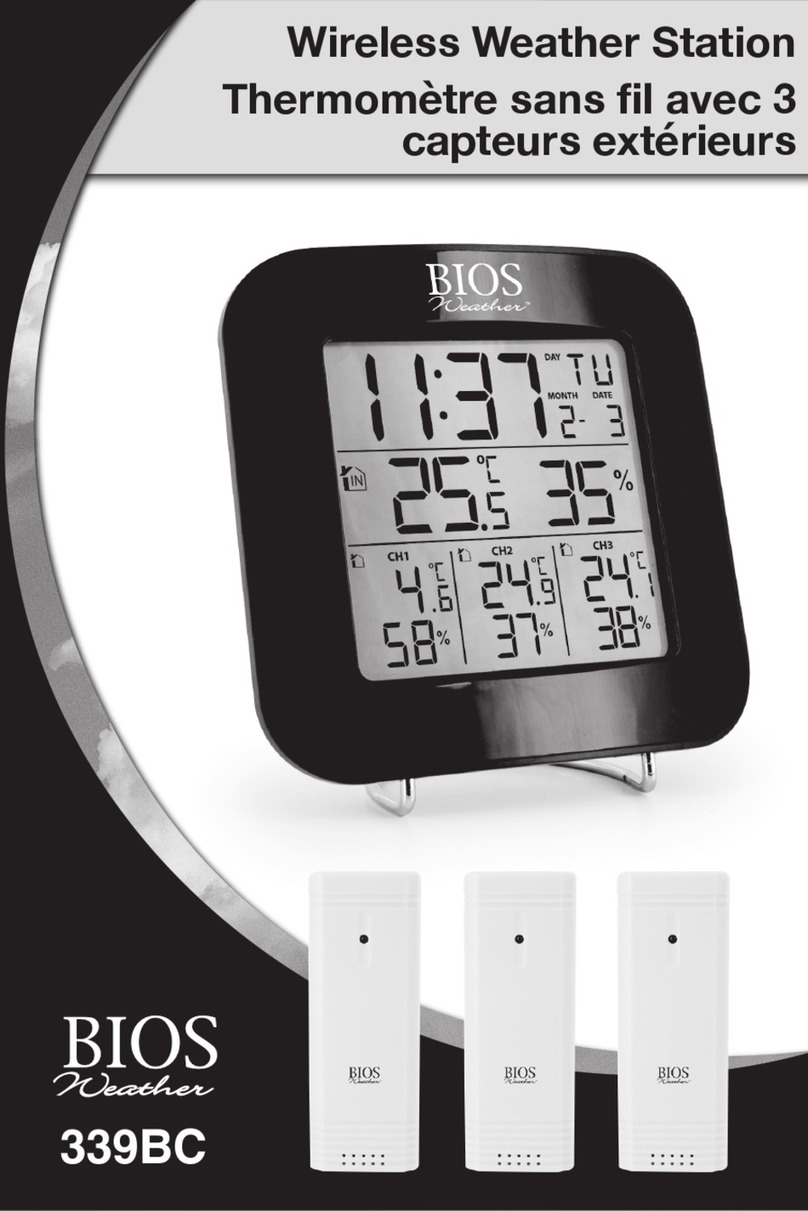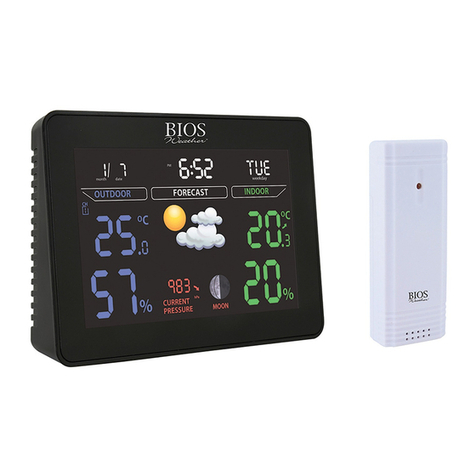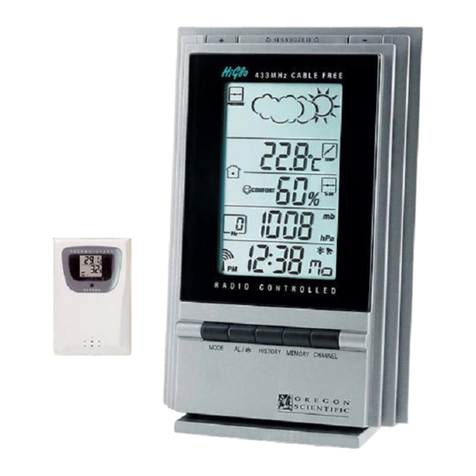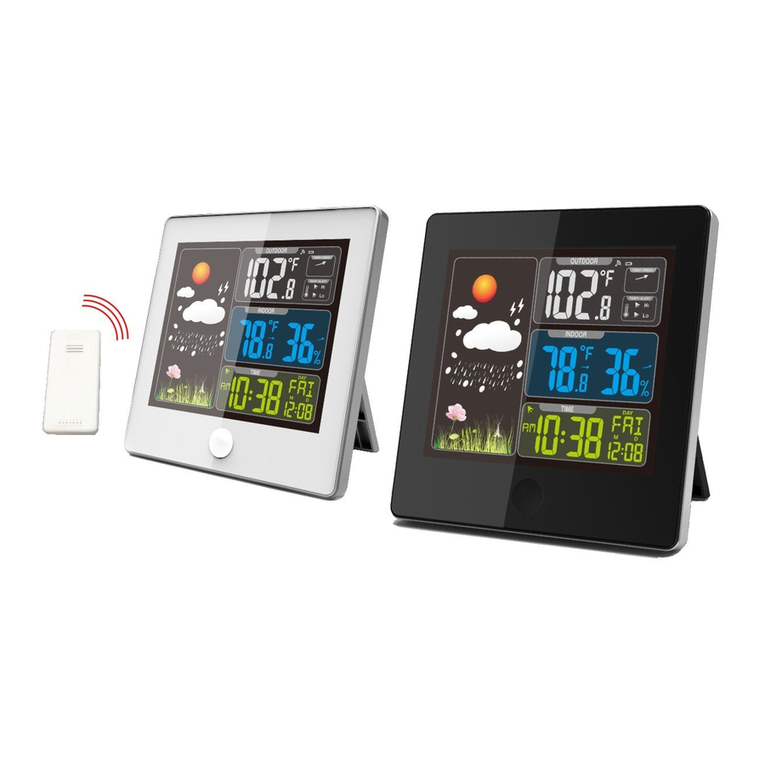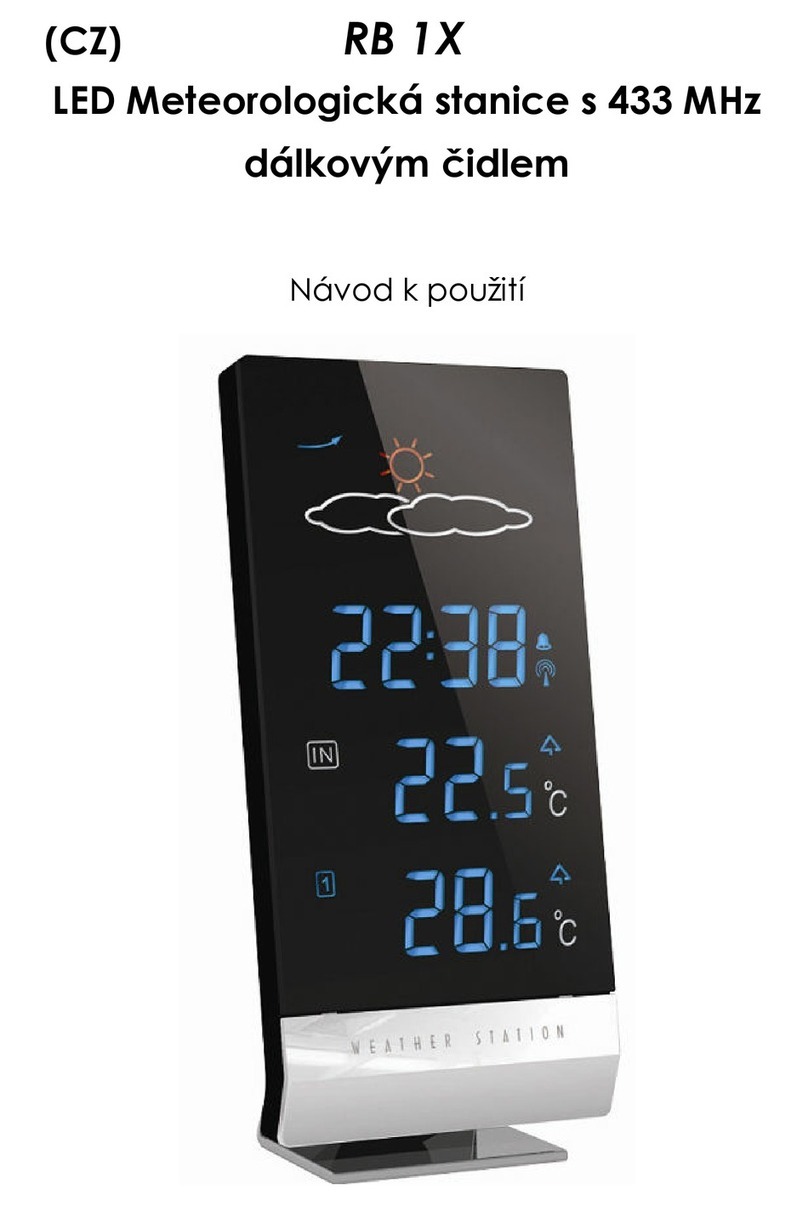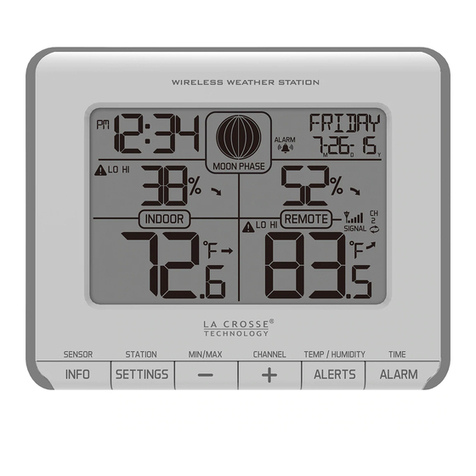BIOS WEATHER BW951 User manual

Home Weather Station
Station météorologique
pour la masinon
BW951

2
2
2
3
3
4
4
4
4
5
5
6
7
8
8
9
9
9
10
10
11
11
11
11
12
12
12
12
13
13
13
13
13
14
14
14
16
22
22
23
23
HOME WEATHER STATION (HWS)
Instruction Manual
Table of Contents
1. Introduction
2. Safety Notes
3. Weather Station Function and Features
Features of the Home Monitor
Features of the Thermometer-Transmitter Sensor
Features of the Wind Sensor
Features of the Rain Sensor
4. Mounting
A. Home Monitor
B. Wind Sensor
• Cable Preparation for Vertical Mounting
• Cable Preparation for Horizontal Mounting
C. Rain Sensor
D.Thermometer-Transmitter Sensor
5. Connecting the Sensors
6. Powering up your HWS
7. Changing Batteries in the Transmitter
8. Wireless Transmission
9. Optimum Viewing Angle
10. Button Breakdown (Quick Reference)
11. Setting the Home Monitor
12. Setting the Alarm
• Alarm Clock
• Indoor Temperature Alarm
• Outdoor Temperature Alarm
13. Turning Off the Alarm(s)
14. Signal Strength
15. Interference Level
16. Indoor/Outdoor Battery Level
17. Minimum or Maximum Memory Recall
18. Minimum or Maximum Memory Reset
19. Rainfall Measurement Reset
20. Trend Chart
21. Weather Forecasting
22. Wind Chill
23. Barometric Pressure
24. Trouble Shooting
25. Product Specifications
26. Warranty
27. Resources
28. FCC Information

This instruction manual is part of this product and should be kept in a safe place for future reference. It contains
important information on setup and operation.
1. INTRODUCTION
Thank you for purchasing the Bios Weather Home Weather Station. Developed with state of the art technology and
digital electronics, this device provides instant readouts of the weather conditions around you.
To understand how to properly install and program your weather station, please read this instruction manual
carefully and keep it in a safe place.
This product is intended to be used at home. It has not been designed for scientific or commercial applications.
2. SAFETY NOTES
• Damages caused by failure to comply with this instruction manual will invalidate any warranty! The manufacturer
and supplier will not be held liable for any damages due to failure to comply with this product!
• In case of harm or damage to a person or property caused by improper handling or failure to comply with this
instruction manual, the manufacturer and supplier cannot be held liable.
• For reason of safety and operation, alternation to this device is strictly prohibited.
• Do not leave discharged batteries in the device as these may corrode and release chemicals that may damage
the unit.
• Do not dispose of new or used batteries in a fire as they may explode or release dangerous chemicals into the
environment.
• This product is not a toy; keep out of reach of children.
• This product is not to be used for medical purposes or for public information.
3. WEATHER STATION FUNCTION AND FEATURES
The home monitor measures the indoor environment of its surrounding area (temperature, humidity and
atmospheric pressure) and receives weather data from the following three outdoor sensors:
1) Thermometer-Transmitter Sensor
2) Wind Sensor (speed and direction)
3) Rain Gauge Sensor (cumulative rainfall)
2

Features of the Home Monitor
• Displays time and date with alarm clock
• Displays weather conditions and records minimum and maximum values
• Displays indoor and outdoor temperature in Celsius (ºC) or Fahrenheit (ºF) -- user selectable
• Displays indoor relative humidity (RH%)
• Displays barometric (air) pressure reading in millibars (mb) or inches of mercury (inHg) -- user selectable
• Displays cumulative rainfall data since last reset in centimeters (cm) or inches (in) -- user selectable
• Displays wind speed in kilometers per hour (km) or miles per hour (mph) -- user selectable
• Wind direction display with LCD compass as well as numerical (e.g. 225º) and abbreviated characters (e.g. NE)
• Wind chill temperature display
• Displays weather forecast using weather icons (sunny, partly cloudy, cloudy or rainy)
• Barometric trend chart in millibars (mb) or inches of mercury (inHg) -- user selectable
• Indoor and outdoor temperature alarms that are set by the user
Time with Alarm
Wind Direction
Wind Chill °C/°F
(min./max.)
Barometric Pressure
mb/inches (min./max.)
Rainfall cm/in
(min./max.)
Barometric Trend, over the
last 24 hours
Temperature Alarm
Date
Wind Speed km/mph
(min./max.)
Indoor & Outdoor Temperature
°C/°F (min./max.)
Indoor Relative Humidity (min./max.)
Forecasts the next 12 hours
based on trends over the
last 72 hours
Battery Power
Transmission Signal Interference Signal
Features of the Thermometer-Transmitter Sensor
The thermometer-transmitter sensor measures the outdoor
temperature. It also collects readings from the rain gauge and wind
sensor, then transmits the data to the home monitor via wireless
433MHz transmission.The transmitter uses four "AA" batteries (not
included).The data from the outdoor sensors are transmitted every
128 seconds to bring you the latest weather information which is
displayed on the home monitor's LCD (updating the information is
prohibited by FCC criteria and would drastically reduce battery life).
Power Adaptor: A special transmitter adaptor is available to supply power
to the transmitter rather than using batteries. It is one of the solutions for
your HWS during extremely cold temperatures in the winter months when
batteries may cause problems. Please call 1-800-387-8520 for ordering
information, if not found at your local retailer.
3
Rain Sensor
Wind Sensor
Thermometer-
Transmitter
Sensor

Features of the Wind Sensor
The wind sensor measures wind speed and wind direction and sends the data to the thermometer-transmitter
sensor, which in turn transmits the data to the home monitor. Operating power is taken from the thermometer-
transmitter sensor by cable connection. The wind sensor consists of the main unit with wind vane, 9m/30 ft. cable
(already attached to the main unit) mast, and base bracket.
Features of the Rain Sensor
The rain sensor measures cumulative rainfall and sends the data to the thermometer-transmitter sensor via cable
connection, which is then transmitted back to the home monitor.The cable connection also supplies operating
power from the thermometer-transmitter sensor to the Rain Sensor. The rain sensor consists of the main unit and
9m/30 ft. cable (already attached to the main unit).
4. MOUNTING
CAUTION: Great care must be taken when mounting the HWS components. The manufactuer/supplier cannot be
held liable for personal or property damage when setting up the components. Please use caution when choosing
a mounting point.
Prior to drilling mounting holes and permanently affixing any of the units, please ensure the following points are
considered:
1. Cable lengths of the units meet with your distance requirements at mounting points.
2. Signal from the thermometer-transmitter sensor can be received by the home
monitor at mounting point.
3. Make sure the transmitter is easily accessible.You will have to periodically replace
batteries. Mount it as close to the ground as possible.
A. Home Monitor
With three retractable legs at the back of the home monitor, the unit can be placed
onto any flat surface or mounted on a wall by using a nail or screw (not provided)
• For accurate data transmission, make sure that the home monitor is not placed in
direct sunlight, or placed in an area with drafts caused by heaters or air conditioners.
• Do not mount the home monitor on a wall which has metal heat/air conditioning
ductwork or high voltage wiring in the wall behind the station, it may interfere with its ability to receive data
from the transmitter.
• Do not mount the home monitor close to fluorescent lights or other electrical appliances. Such devices
dramatically decrease signal reception, and in some cases, prevent all signals from reaching the home monitor.
• If the main unit is in area of transmission interference (e.g. on or near concrete walls, home appliances, computers
or metal objects) the distance of transmission will be drastically reduced or non-existent.
4
Desk Mount Position Table Top Position Wall Mount

5
B. Wind Sensor
First, choose whether the wind sensor will be mounted vertically or
horizontally (on a mast). Make sure that you position the wind sensor in
a free, open area that is not protected by objects, which may distort or
interfere with the wind (e.g. large buildings, trees, chimney, etc.).
NOTE: Make sure the following contents have been included with your
HWS for mounting the wind sensor:
• 2 x U-bolts to secure to a mast
• 8 x washers
• 4 x nuts
• 8 x 0.25" screws (to fix mast to main unit and base bracket)
• 4 x 2.75" screws (to fix base bracket to a flat surface)
Cable Preparation for Vertical Mounting
1. Run the cable that is already fastened to the wind sensor through
the vertical joining section (see right).
2. Run the cable through the extension pole but do not secure the pole
to any sections yet.
3. Now run the cable through the top of the base-bracket and then
through the small rectangular section found on one side of the base-
bracket.
NOTE: Make sure that you completely pull the cable through the wind sensors extension pole and base-bracket to
reduce the amount of slack on the cord.
Vertical Mount
1. Make sure that the wind vane can rotate freely before fastening
the unit permanently into position.
2. Insert one end of the extension pole provided into the base-
bracket.
3. Secure the connection point of the extension pole and base-
bracket using the 0.25" metal screws provided to prevent rotation
at the joining point. (Use 4 x 0.25" screws to ensure stability).
4. Insert the vertical joining section on the bottom of the wind
sensor into the top of the extension pole. (Ensure that you pull
all cable slack through the side of the base-bracket to prevent
creasing or cutting the cable).
5. Secure the wind sensor to the extension pole using the 0.25"
screws provided to make sure that the pole connection does not
rotate. (Use 4 x 2.75" screws to ensure stability).
IMPORTANT: For accurate readings, it is important to mount
the wind sensor so that the "N" (north) on the casing is facing
the correct direction (north). If necessary, use a standard
compass to determine north.
6. Using 4 x 2.75" screws provided, secure the wind sensors base-
bracket to a flat surface.
NOTE: Make sure that when you are securing the base bracket
with the 2.75" screws,you are aware of the cable.Prevent driving
a screw through the cable!
VERTICAL MOUNT
²
Fig. A

NOTE: For proper wind speed measurement ensure the vertical joining section is at 90º the horizon
(Fig.A).
Horizontal Mounting
Cable Preparation for Horizontal Mounting
1. Run the cable that is already fastened to the wind sensor through the horizontal joining section (see below).
2. Run the cable through the extension pole but do not secure the pole to any sections yet.
3. Now run the cable through the top of the base-bracket and then through the small rectangular section found
on one side of the base-bracket.
NOTE: Make sure that you completely pull the cable through the wind sensor's extension pole and base-bracket to
reduce the amount of slack on the cord.
Horizontal mount - using a mast/antenna/pole
NOTE: It is not recommended to secure the wind sensor horizontally from a wall or chimney because doing so will
interrupt the flow of wind from at least one direction.
MOUNT WITH "N" FACING NORTH:
For accurate readings , it is important to mount the wind sensor so that the "N" (north) on the casing is facing the
correct direction (north). If necessary, use a standard compass to determine north.
1. Make sure that the wind vane can rotate freely before fastening the unit permanently.
2. Using the 2 x U-bolts, 4 x nuts and 4 x washers, secure the base-bracket of the wind sensor to a stable mast/
antenna/pole. (Masts made of magnetic materials, such as lead or other dense metals will cause faulty readings).
IMPORTANT: Make sure that the pole insert of the base-bracket is facing north (N) and pilot holes are on the top
AND bottom.
3. Use the extension pole provided to distance the wind sensor from the stable mast/antenna/pole. Insert one end
of the extension pole into the base-bracket.
4. Secure the connection point of the pole extension and base-bracket using the 0.25" screws provided to prevent
rotation at joining point. (Use the 4 x 0.25" screws to ensure stability).
5. Insert the pole extension into the horizontal joining section. (Ensure that you pull all cable slack through the side
of the base-bracket to prevent creasing or cutting the cable).
6. Secure the horizontal joining section to the mount pole using the 0.25" screws provided to make sure that the
pole connections does not rotate.
6

HORIZONTAL MOUNT
C. Rain Sensor
NOTE: Make sure the following contents have been included with your HWS for mounting the rain sensor.
• 2 x 2.75" screws (to fix rain sensor to a flat surface)
Place the rain sensor as far away as possible from tall buildings, trees or other obstructions. It is suggested that
the rain sensor should be no closer to tall objects or obstructions than twice the height of the object compared to
the sensor. However, low bushes, fences or walls in the vicinity of the gauge are not objectionable, as these usually
help break up the force of the wind during stormy weather conditions.
NOTE: It is recommended that you mount the rain sensor 18" (46 cm) above ground or surface to prevent water
from splashing off the ground/surface, into your rain gauge.
1. In order for the rain sensor to work properly, you MUST place the rain sensor on a level, horizontal
surface. Use of a bubble level (not included) will ensure proper mounting.
2. Remove the rain gauge lid by pushing on the tabs at either end, and pulling it upwards off the base.
3.Test that water can flow freely between the base of the rain sensor and horizontal mounting surface - pour clear
water over the water collection device and view the flow.
4. Using 2 x 2.75" screws, secure the base of the rain gauge to the flat, horizontal surface.
• It is recommended that you inspect and clean your rain gauge every couple of months. Remove any leaves that
may have fallen into the collection bowl.
• Remove the lid on the rain gauge and check if there is anything obstructing the tipping bucket mechanism.
• The rain gauge is not designed to register snowfall, therefore to avoid damage to the unit, it is recommended that
you bring the unit in during the winter, or if it is mounted in a permanent position, cover it to protect it from
snowfall.
(Also push on
the other side)
7

D. Thermometer-Transmitter Sensor
It is recommended to mount the thermometer-transmitter sensor in a shaded area out of reach of direct sunlight.
Placing the transmitter in direct sunlight will affect the outdoor temperature considerably.
It is recommended to mount the unit approximately 2 m /6 ft above the ground on the north side of a structure
preferably in a shaded area.
NOTE: Make sure the following contents have been included with your HWS for mounting the transmitter:
• 2 x 1.75" wall mounting screws
• plastic anchors for screws
Wall Mount
1. Affix the wall bracket onto a desired wall using the 1.75" screws provided
2. Insert the plastic plug on the back of the thermometer-transmitter sensor into the wall bracket socket.
Vertical Mount
1. Affix the wall bracket onto a flat, horizontal surface using the 1.75" screws provided.
2. Plug in the thermometer-transmitter using the plug found on the bottom of the sensor into the wall bracket
socket. DO NOT mount the thermometer-transmitter sensor upside down.
5. CONNECTING THE SENSOR
Thermometer-Transmitter Sensor
You must insert the cables that run from the outdoor sensors into
the corresponding sockets on the thermometer-transmitter before
you can begin to power up your home weather station.
1.You will see three sockets: one for the wind sensor, one for the
wired transmission, another for the rain sensor (see Diagram C).
2. Connect the cables of the wind and rain sensors to the
corresponding sockets on the thermometer-transmitter by
'clicking' them into place.
8
WALL MOUNT VERTICAL
MOUNT

6. POWERING UP YOUR HWS
NOTE: The AC/DC adaptor should be used as the primary power source for the home monitor and batteries
should only be used for back up purposes in case of a power outage.
1. Plug in the AC/DC adaptor to the power outlet in your wall.
2. Insert the adaptor into the DC socket located on the
right side of the home monitor.
3. Once the adaptor has been plugged in, "IO" will flash on the top
left side of the LCD and "---" will appear in the center of the
compass rose. (See diagram A).
4. Remove the battery cover on the thermometer-transmitter sensor.
5. Insert 4 x "AA" batteries according to the correct polarity.
6. If the home monitor is receiving transmissions properly from the
thermometer-transmitter sensor, a transmission ID number will
appear in the center of the compass rose on the home monitor
(e.g. 104, 241, etc.) (See diagram B).
NOTE: If no transmission ID number appears after 4 minutes, remove
the batteries from the transmitter and uplug the AC/DC adaptor
from the home monitor and start from step one.
7. Once the transmission ID number and the "IO" stop flashing on the LCD, press the SET button on the monitor
to store the transmission ID.The monitor will automatically go to the normal display mode.
8. Replace the battery cover and the rain cover on the thermometer-transmitter sensor.
9. After the set up is complete you can now insert 3 x "AA" batteries into the home monitor for back up
purposes only.
IMPORTANT: It is very important that the steps in "Powering Up Your HWS" are followed precisely. Missing a step
or not performing the steps in order will result in the home weather station to not function properly and therefore
will result in incorrect readings.
7. CHANGING BATTERIES IN THE TRANSMITTER
1. Press and hold the DISPLAY button until the LCD exits the normal display mode and "IO" begins to flash in the
top left corner.
2. Follow steps 5-9 in the "Powering Up Your HWS" section above.
8. WIRELESS TRANSMISSION
The HWS utilizes a transmitter, which broadcasts at 433 mHz approximately every 128 seconds to conserve battery
life. Like a cell phone signal, the transmission strength is affected by many
external objects that cause electromagnetic interference. Proximity to power and
electrical appliances adversely affect the signal. Therefore, we strongly advise
that you experiment with the placement of both the transmitter and the home
monitor. If the conditions are good, you will be able to transmit at the maximum
range of 60 meters / 200 feet, but if you are in an area with a lot of interference,
the range will be less (View "Mounting Home Monitor" on page 4).
Once the unit is powered up correctly, the thermometer-transmitter will start to
send weather information to the home monitor.
9
Diagram C
Diagram A Diagram B
IO
IO

9. OPTIMUM VIEWING ANGLE
You must always keep in mind that the LCD screen is constructed
with an "optimum viewing angle".
Your eye should be at a 45º angle to view the LCD screen clearly.
10
45º
No. BUTTON FUNCTION
1. ALARM
Button
• Press and release to enter "Alarm Set Mode"
• Toggles between the multiple segments of the "Alarm Set Mode"
• Turns all sounding alarms off (Alarm clock, indoor/outdoor temperature alarms)
2.
and
3.
"+" Button
"-" Button
• Increases/decreases values in the "Set Display Mode" (time and date)
• Increases/decreases values in "Alarm Display Mode" (clock alarm, indoor temperature alarm
and outdoor temperature alarm)
• Press and hold the "+" button to reset cumulative rainfall memory
• Toggles between mode settings in the "Set Display Mode" (ºC , ºF, km, mph, mb, inch/inHg,
cm, inch)
• "-" button activates backlight in the "Normal Display Mode"
4. Display
Button
• Runs through 10 different display combinations with assorted sections on the LCD
• Press and hold to enter "ID Setting Mode" if changing transmitter batteries
5.
and
6.
MIN
Button
MAX
Button
• Displays minimum/maximum memory recordings (Wind Chill, Wind Speed, Indoor/Outdoor
Temperature, Pressure, Rainfall and Humidity)
• Press and hold the MIN button to reset ALL minimum memory recordings
• Press and hold the MAX button to reset ALL maximum memory recordings
7. SET
Button
• Press and hold to enter "Set Display Mode"
• Toggles between the multiple segments of the "Set Display Mode"
• Activates alarms in the "Alarm Set Mode" (clock alarm, indoor temperature alarm and
outdoor temperature alarm)
• Press to store the transmission ID when in the "ID Setting Mode"
1
2
3
4
5
6
7
10. BUTTON BREAKDOWN (Quick Reference)

11. SETTING THE HOME MONITOR
NOTE: If you press the DISPLAY button, the LCD screen will display certain sections. Continually press the DISPLAY
button to get through the different display sections eventually returning to the "Normal Display Mode". If you
pause at any time for more than 7 seconds while setting the time, date or measurement preferences, the home
monitor will automatically exit the "Set Display Mode".
"Set Display Mode" - Personalized Settings
Time:
1. Press and hold the SET button for 3 seconds to enter "Set Display Mode".
2.The hour digit(s) will begin to flash.
3. Using the "+" or "-" buttons, toggle until you reach the correct hour(s).
4. Press the SET button again.
5.The minute digit(s) will begin to flash.
6. Repeat steps 3-4 to set the minutes, year, month and date.
Wind Speed,Temperature, Pressure, Rainfall:
7. After setting the date, the "Wind Speed" and the current unit of measurement (km / mph) will begin to flash.
8. Using the "+" or "-", toggle to your preferred unit of measure - kilometers (km) or miles (mph).
9. Once you have decided on your preference, press the SET button .
10. Repeat steps 8-9 to set your preferred measurements for temperature (ºC / ºF), pressure (mb / inHg) and
rainfall (cm / in).
NOTE: Inches of mercury are represented as "inHg" (on the "Trend" chart) and as "inch" (under the "Pressure"
segment) - both represent the same unit of measure.
12. SETTING THE ALARM
If you pause at any time for more than 7 seconds while setting the time, indoor or outdoor temperature alarms, the
home monitor will automatically exit the "Alarm Set Mode".
Alarm Clock:
1. Firmly press and release the ALARM button for no more than 2 seconds to enter the "Alarm Set Mode".
2.The hour digits will begin to flash.
3. Using the "+" or "-", toggle until you reach the desired hour(s) for the alarm clock to sound.
4. Press the ALARM button again.
5.The minute digit(s) will begin to flash.
6. Repeat steps 3-4 to set the minutes.
7.“((•))”icon will begin to flash.
8.To activate the alarm, press the SET button.The “((•))” icon will stop flashing to indicate that the alarm is active.
(To have the alarm inactive, ensure that the “((•))” icon is flashing).
Indoor Temperature Alarm:
9. Press the ALARM button again to progress to the indoor temperature alarm.
10. "INDOOR" and "TEMP" will begin to flash.
11. Using the "+" or "-", toggle until you reach the desired temperature for the temperature alarm to sound.
12. Press the ALARM button again.
13.“((•))” icon will begin to flash.
14.To activate the indoor temperature alarm, press the SET button.The “((•))” icon will stop flashing to indicate that
the alarm is active. (To have the alarm inactive, ensure that the “((•))” icon is flashing).
11

Outdoor Temperature Alarm
15. Press the ALARM button again to progress to the outdoor temperature alarm.
16. "TEMP" and "OUTDOOR" will begin to flash.
17. Repeat steps 11-14 to set your outdoor temperature alarm.
NOTE:
• When the clock alarm sounds, the “((•))” logo on the LCD will begin to flash to the right of the time.
• When the temperature alarm sounds, the LCD will indicate which alarm is ringing by flashing "INDOOR" or
"OUTDOOR" and the “((•))” logo.
• If both the indoor and outdoor alarms are sounding, "INDOOR" and "OUTDOOR" and the “((•))” logo will flash.
13. TURNING OFF THE ALARM(S)
• If any of the alarms sound, press and release the ALARM button to deactivate the signal ("beeping"). “((•))” flashes
to indicate which alarm has sounded.This will only turn off the alarm that has sounded at that particular point in
time. Example: If the alarm clock sounds and the temperature alarms are set, you can press the ALARM button to
turn off the alarm clock, however, the temperature alarms will remain active.
• Once you have deactivated a sounding alarm by pressing the ALARM button, you must reset the alarm by
following all the steps in the "Setting the Alarm" section.
14. SIGNAL STRENGTH
This icon indicates the strength of the transmission between the transmitter and the home monitor. The signal
strength is represented by three levels:
15 . INTERFERENCE LEVEL
This interference icon determines the amount of transmission interference that is around the home monitor. If
the home monitor is in an area with high transmission interference the icon on the monitor will constantly be
displayed.The interference signal is represented by three levels:
12

16. INDOOR/OUTDOOR BATTERY LEVEL
The battery level shows the actual voltage of the battery in the transmitter and the home monitor. The battery
level is represented by three levels:
When there are no batteries in the home monitor or transmitter the battery icon will flash.
17. MINIMUM OR MAXIMUM MEMORY RECALL
Press the MIN button to recall all the minimum recorded weather measurements. (Including Wind Chill, Wind
Speed, Indoor Temperature, Outdoor Temperature, Pressure and Humidity).
Press the MAX button to recall all the maximum recorded weather measurements. (Including Wind Chill, Wind
Speed, Indoor Temperature, Outdoor Temperature, Pressure, Humidity and Rainfall).
18. MINIMUM OR MAXIMUM MEMORY RESET
Press and hold the MIN button for 4 or more seconds to reset all the minimum recorded weather measurements.
Press and hold the MAX button for 4 or more seconds to reset all the maximum recorded weather measurements.
19. RAINFALL MEASUREMENT RESET
The Home Weather Station calculates cumulative rainfall.To reset the rainfall reading, press and hold the "+"
button for 4 or more seconds. "---" (dashes) will appear to indicate that the rainfall has reset. After 128 seconds, the
reading will return to 0.0 cm (or 0.0 inch).
20. TREND CHART
Please review the following tips on understanding your trend chart.
NOTE:
• The trend chart will not appear on the LCD after powering up the home monitor for the first time. It has to collect
air pressure data for 24 hours before it can display a trend.
• If at anytime power is lost to the home monitor, all trend information will be erased and must be collected again
for 24 hours to display a trench once the power is restored.
13

21. WEATHER FORECASTING
• Weather forecasting is an extremely complex science. Even professional meteorologists with the best equipment
and the aid of radar and satellite imagery often have difficulty forecasting with absolute certainty.The
predication models meteorologists use consider many weather variables, including; barometric pressure, wind
direction, wind speed, dew point, etc.
• The forecast function in the Home Weather Station is based solely on barometric pressure and the trend
recordings of general weather conditions associated with various pressure levels. It therefore has a limited ability
to forecast for the multitude of specific conditions it will encounter. It provides a general forecast of weather
changes in the same way a wall barometer forecasts changes in weather, however it does record and account for
trends that influence the forecast icon.
IMPORTANT:
• The forecast icon will always appear as "Partly Cloudy" upon powering up the home monitor. During this time, the
main station is collecting pressure information in order to generate a proper forecast.
• The first 72 hours of forecast icons may be inaccurate from what you are viewing out your window, however,
the unit continually gathers pressure data to develop trends, in turn predicting forecasts of coming weather
conditions.The longer that station is powered increases the forecast accuracy.
22. WIND CHILL
• Wind chill is a combination of both outdoor temperature and wind speed.
• For the wind chill to display on the home monitor the outdoor temperature needs to be above -50ºC (-58ºF) and
below 10ºC (50ºF) and the wind speed needs to be above 4.8 km/hr (3 mph) and below 177 km/hr (110 mph). If
the outdoor temperature and wind speed are out of the range the wind shill will display dashes ("---").
23. BAROMETRIC PRESSURE
• The Home Weather Station's barometer display will differ from local sources (TV, radio, internet, etc.).This is
because the barometric pressure quoted in these types of mediums is "barometric pressure adjusted to sea
level", which is theoretical atmospheric pressure that accounts for decreasing air pressure with elevation. Air
pressure decreases 1.0 inHg for every 30 meters / 1000 feet you go up in elevation. Consequently, the air pressure
at the top of a mountain is considerably less than at sea level.
• The HWS uses a sensor to measure the "absolute" or actual barometric pressure. For forecasting purposes,
however, the relative changes in pressure and pressure trends indicate the coming weather. In general, rising
pressure indicates improving weather, while falling pressure indicates deterioration of current conditions.
14

15
Above Sea Level
City
Saskatoon, SK
Prince George, BC
St. John’s, NF
Thunder Bay, ON
Toronto, ON
Vancouver, BC
Victoria, BC
Whitehorse,YT
Winnipeg, MA
Yellowknife, NT
m
504
691
140
199
173
4
19
706
239
206
feet
1653
2266
459
653
567
13
62
703
784
676
City
Calgary, AB
Charlottetown, PE
Churchill Falls, NF
Edmonton, AB
Fredericton, NB
Halifax, NS
Iqaluit, NU
Montreal, QC
Ottawa, ON
Quebec City, QC
Regina, SK
m
1049
49
449
670
21
51
33
36
114
74
577
feet
3440
161
1443.20
2198
69
167
108
118
374
243
1893
Above Sea Level
US City Altitude US City Altitude
(feet above (feet above
sea level) sea level)
Miami, FL 10
Milwaukee, WI 635
Minneapolis, MN 815
Nashville-Davidson, TN 450
New Orleans, LA 5
New York, NY 55
Oakland, CA 25
Oklahoma City, OK 1,195
Omaha, NE 1,040
Philadelphia, PA 100
Phoenix, AZ 1,090
Portland, OR 77
Sacramento, CA 30
St. Louis, MO 455
San Antonio, TX 650
San Diego, CA 20
San Francisco, CA 65
San Jose, CA 90
Seattle, WA 125
Tucson, AZ 2,390
Tulsa, OK 804
Virginia Beach, VA 10
Washington, DC 25
Wichita, KS 1,290
Albuquerque, NM 4,945
Austin, TX 505
Baltimore, MD 20
Boston, MA 21
Charlotte, NC 720
Chicago, IL 595
Cleveland, OH 660
Colorado Springs, CO 5,890
Columbus, OH 780
Dallas, TX 435
Denver, CO 5,280
Detroit, MI 585
El Paso, TX 3,695
Fort Worth, TX 670
Fresno, CA 285
Honolulu, HI 21
Houston, TX 40
Indianapolis, IN 717
Jacksonville, FL 20
Kansas City, MO 750
Las Vegas, NV 2,030
Long Beach, CA 29
Los Angeles, CA 340
Memphis, TN 275
Mesa, AZ 244
TABLE 1: Elevation of
Major Cities in Canada
TABLE 2: Elevation of Major Cities in the US
NOTE: The elevation in meters (m)
and feet (ft) refers to the elevation of
the observing location above mean
sea level according to Environment
Canada: http://www.climate.weather-
office.ec.gc.ca/climateData/canada_
e.html

16
24. TROUBLESHOOTING
LCD is blank
Outdoor information is not
displayed, "---"
NOTES on items in the home
that generate frequency
trouble:
• Family radios (CB's, walkie-
talkies)
• Digital cable or satellite boxes
radiate frequencies that will
interfere with transmission
• HAM radios
• Microwave Ovens
• High voltage wiring
Wind speed does not change
A.This occurs because there is no power supplied to the main unit.
1. Check the AC power connections to the receiving unit and the power from
the wall outlet.
2. Check the batteries and replace if needed (View Section 7: Changing
Batteries in the Transmitter).
3. Check the polarity of the batteries in the battery compartment.
4. Press the DISPLAY button to see if you are in a particular display mode
screen.
A.This is usually caused by transmission interference or low battery power in
the transmitter.
i) Are there dashes for the outdoor temperature reading?
ii) Are there dashes for the wind speed reading?
iii) Are there dashes for the wind direction reading?
IF YES TO ALL QUESTIONS ABOVE:
1. Check batteries in the transmitter. Replace if needed. (View Section 10:
Changing Batteries in the Transmitter).
2. Bring the monitor beside the transmitter and remove all the batteries.
Replace them all (View Section 6: Powering Up Your HWS) and observe
whether ALL the outdoor readings show up. Check the timing of updates
on the home monitor (outdoor readings should change every 128
seconds). Then, place the monitor back in the regular position. Check
the timing of updates AGAIN on the monitor. If you notice the updates
occur every 128 seconds, there should be no problem. If the screen has
not updated within 5 minutes or no updates occur there is transmission
interference between the receiver and the transmitter. BOTH UNITS
MUST BE PLACED IN DIFFERENT LOCATIONS TO REDUCE TRANSMISSION
INTERFERENCE.
IF THERE ARE DASHES ONLY WHERE THE WIND SPEED AND DIRECTION
ARE DISPLAYED AND THE UNIT IS REGISTERING AN OUTDOOR
TEMPERATURE:
3. Check that the wires are connected from the wind speed to the
transmitter in the right slot (labeled "wind") and are fully inserted. If the
wind sensor was not inserted properly, remove the batteries from both
components and re-insert them. (View Section 6: Powering Up Your HWS).
A.This is usually an indication that the batteries have died in the transmitter.
1.To conserve battery power, the transmitter broadcasts the wind speed
data (and all other weather information) every 128 seconds (2 min. 8 sec.)

17
Outdoor readings stopped after
two days, one week, etc.
to the home monitor. (View Section 8: Wireless Transmission).
2. Check the batteries in the transmitter. Replace if needed. (View Section 7:
Changing Batteries in the Transmitter).
3. Make sure that the wind speed sensor cord is securely fastened in the
"wind" slot on the transmitter. (View Section 5: Connecting the Sensors).
4. Bring the monitor beside the transmitter and remove all the batteries.
Replace them all (View Section 6: Powering Up Your HWS) and observe
whether ALL the outdoor readings show up. Check the timing of updates
on the receiving unit (outdoor readings should change every 128
seconds).Then, place the monitor back in the regular position. Check the
timing of updates AGAIN on the receiving unit. If you notice the updates
occur every 128 seconds, there should be no problem. If the screen has
not updated within 5 minutes or no updates occur there is transmission
interference between the receiver and the transmitter. BOTH UNITS
MUST BE PLACED IN DIFFERENT LOCATIONS TO REDUCE TRANSMISSION
INTERFERENCE.
5. Freezing rain can cause the wind direction pointer to stop moving, thus
constantly displaying the same direction. You can attempt to remove
the ice from the wind sensor, but it is strongly advised to wait for milder
weather to do so.
1. Battery voltage supplied by the 4 x "AA" batteries in the transmitter
is affected by cold weather, especially alkaline batteries. Low voltage
decreases the transmission distance significantly. If you are experiencing
weather below -10ºC/14ºF, it is suggested to use lithium batteries and
place the monitor and transmitter as close as possible to each other.
• Power Adaptor: a special transmitter adaptor is available to supply power
to the transmitter rather than using batteries. It is a perfect solution for
your HWS during extremely cold temperatures in the winter months when
batteries may cause problems. Please call 1-800-387-8520 for ordering
information if not found at a local retailer.
2. Electrical storms can cause transmission to stop. If this occurs, you must
reset the monitor and transmitter by removing the batteries and re-
inserting them correctly (View Section 6: Powering Up Your HWS). DO NOT
do this during the electrical storm!
3. Electromagnetic interference can occur from different sources that
transmit radio waves that may affect how the main unit receives data from
the transmitter (if at all). It is recommended that you place the transmitter
and monitor significantly close together if there is a large amount
of electromagnetic interference in your area. Even interference from
appliances in your home may cause transmission to stop.

18
Wind direction is displaying
faculty readings
Wind direction is stuck on one
direction
4. Bring the monitor beside the transmitter and remove all the batteries.
Replace them all (View Section 6: Powering Up Your HWS) and observe
whether ALL the outdoor readings show up. Check the timing of updates
on the home monitor (outdoor readings should change every 128
seconds).Then, place the monitor back in the regular position. Check the
timing of updates AGAIN on the receiving unit. If you notice the updates
occur every 128 seconds, there should be no problem. If the screen has
not updated within 5 minutes or no updates occur there is transmission
interference between the receiver and the transmitter. BOTH UNITS
MUST BE PLACED IN DIFFERENT LOCATIONS TO REDUCE TRANSMISSION
INTERFERENCE.
i) Are you mounting the unit on a mast or metal pole?
ii) Do you know what the pole is made of?
1. Aluminum poles should not affect the wind direction readings, however,
masts or poles made of lead or other dense metals can affect the magnetic
sensors in the wind sensor causing the unusual readings. Move the wind
sensor, if necessary, or use the vertical mount procedure. (View Section 4:
Mounting).
2. Freezing rain can cause the wind direction pointer to stop moving, thus
constantly displaying the same direction.You can attempt to remove the
ice from the wind sensor, but it is strongly advised to wait for milder
weather to do so.
3. Check the batteries in the transmitter. Replace if needed. (View Section 6:
Powering Up Your HWS).
4. Make sure that the wind speed sensor is securely fastened in the "wind"
slot on the transmitter. (View Section 5: Connecting the Sensors).
5. Bring the monitor beside the transmitter and remove all the batteries.
Replace them all (View Section 6: Powering Up Your HWS) and observe
whether ALL the outdoor readings show up. Check the timing of updates
on the home monitor (outdoor readings should change every 128
seconds).Then, place the monitor back in the regular position. Check the
timing of updates AGAIN on the receiving unit. If you notice the updates
occur every 128 seconds, there should be no problem. If the screen has
not updated within 5 minutes or no updates occur there is transmission
interference between the receiver and the transmitter. BOTH UNITS
MUST BE PLACED IN DIFFERENT LOCATIONS TO REDUCE TRANSMISSION
INTERFERENCE.

19
Pressure reading is too high /
low / changed
Only transmits when the
transmitter is right beside the
receiver
No outdoor reading occur even
after resetting the units
The pressure sensor in your weather station is very sensitive to voltage
changes if you scroll through the display screen (using the DISPLAY button)
or plug in the AC adaptor with the batteries in it, the pressure may change
because the voltage to the sensor has either increases or decreased. After
a very short period of time, the pressure sensor will adjust itself back to the
correct pressure readings.
A.There is a large amount of transmission interference with the current
location of the main unit and transmitter. There may be too many walls
or electrical interference (caused by appliances in your home) between
the two units.
1. Significantly reduce the distance between the main unit and the
transmitter.
2. Bring the monitor beside the transmitter and remove all the batteries.
Replace them all (View Section 6: Powering Up Your HWS). Connect the
sensors and observe whether ALL the outdoor readings show up. Check
the timing of updates on the home monitor (outdoor readings should
change every 128 seconds). Then, place the monitor back in the regular
position. Check the timing of updates AGAIN on the receiving unit.
If you notice the updates occur every 128 seconds, there should be no
problem. If the screen has not updated within 5 minutes or no updates
occur there is transmission interference between the receiver and the
transmitter. BOTH UNITS MUST BE PLACED IN DIFFERENT LOCATIONS TO
REDUCE TRANSMISSION INTERFERENCE.
A. Make sure that you have unplugged and removed the batteries from the
main unit AND the transmitter. Re-insert the batteries in the transmitter
ONLY. Put the transmitter directly on top of a radio (preferably a clock-
radio due to the size - stereo radios may be too large for this test), and
turn the radio to FM 107.9.You should hear a loud beep or pulse roughly
every 128 seconds.Time the pulse to ensure this occurs approximately
every 128 seconds. If no pulse is heard, the transmitter's batteries are
dead or the trasnmisster is defective.
If the pulse does occur approximately every 128 seconds, place the main
unit and the transmitter side by side (turn off the radio). Bring the
monitor
beside the transmitter and remove all the batteries. Replace them all
(View Section 6: Powering up your HWS) and observe whether ALL the
outdoor readings show up. Check the timing of updates on the home
monitor (outdoor readings should change every 128 seconds). Then,
place the receiver back in the regular position. Check the timing of
updates AGAIN on the receiving unit. If you notice the updates occur
every 128 seconds, there should be no problem.
If the screen has not updated within 5 minutes or no updates occur there
is transmission interference between the receiver and the transmitter.
Table of contents
Other BIOS WEATHER Weather Station manuals
Popular Weather Station manuals by other brands
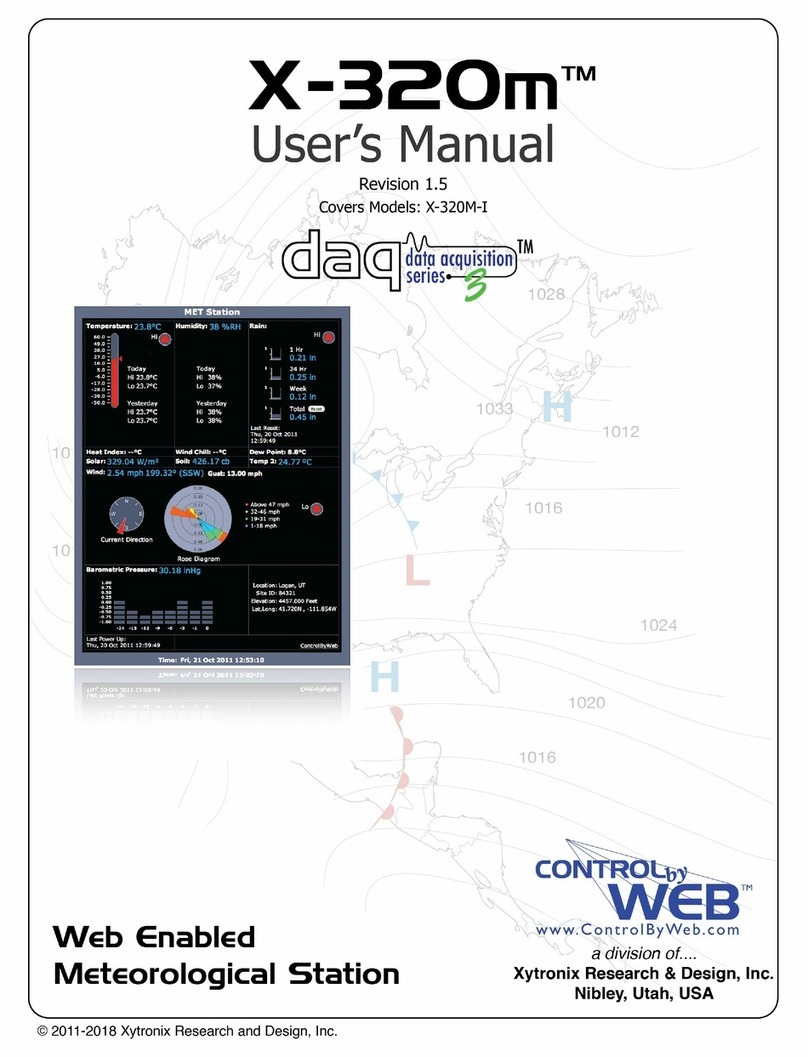
ControlByWeb
ControlByWeb X-320m user manual

RADEMACHER
RADEMACHER DuoFern 9475 Additonal operating & safety instructions
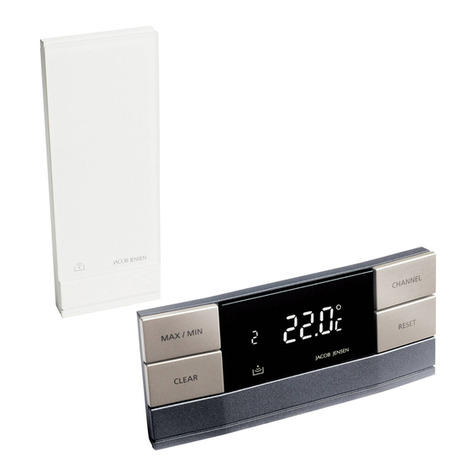
Jacob Jensen
Jacob Jensen Temperature Station user manual
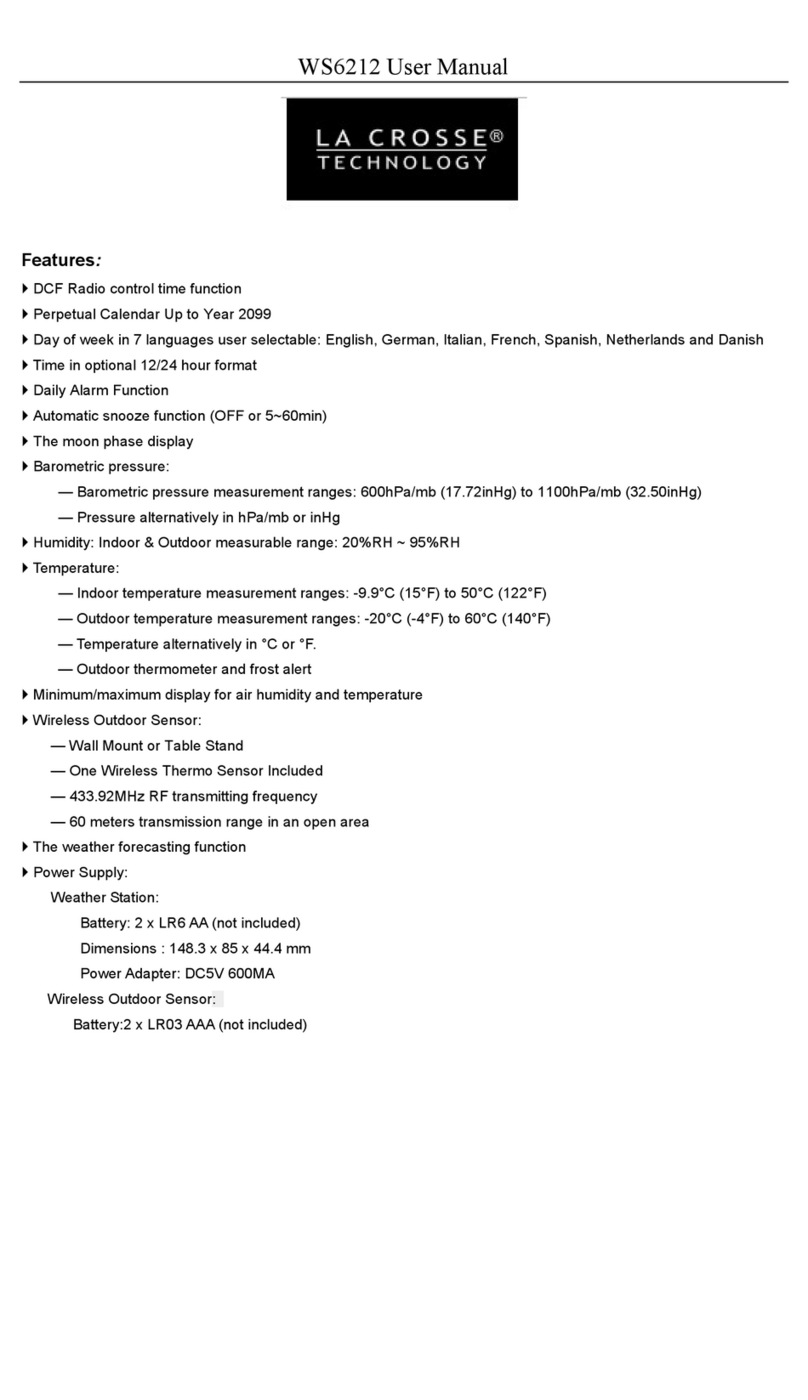
La Crosse Technology
La Crosse Technology WS6212 user manual
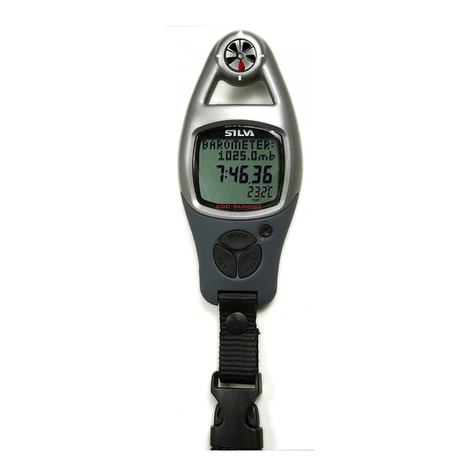
Silva
Silva ADC Summit quick guide

La Crosse Technology
La Crosse Technology WD-2513U owner's manual
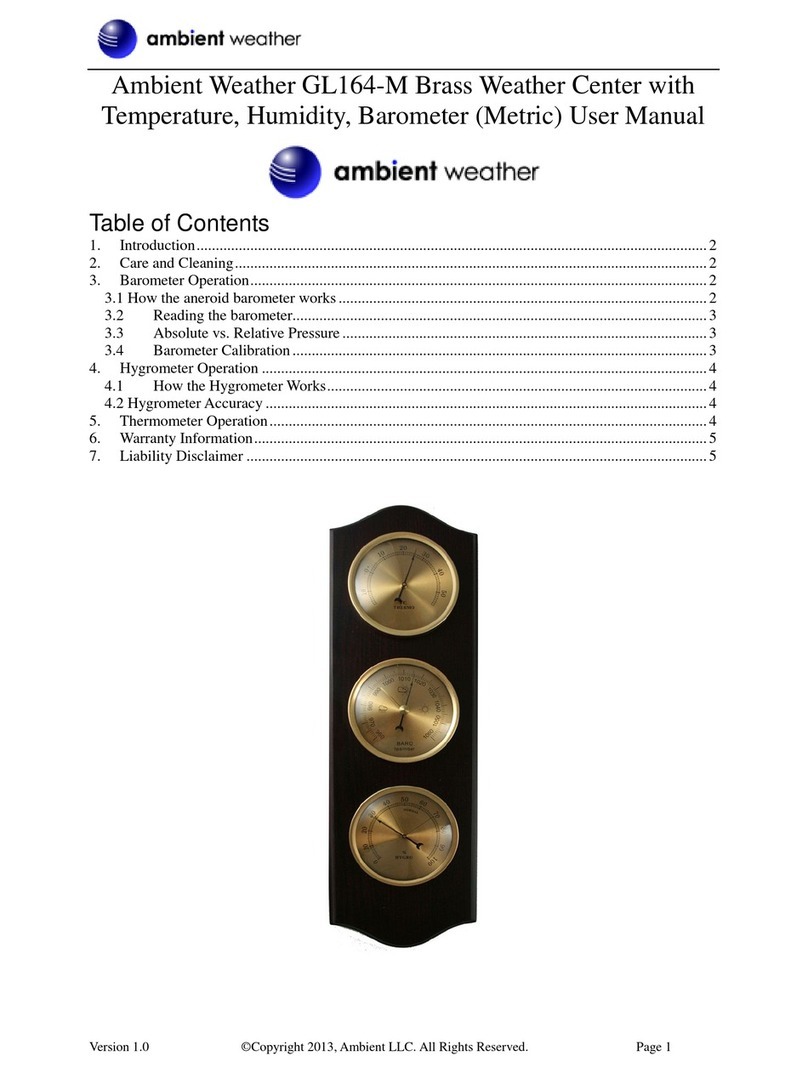
Ambient Weather
Ambient Weather GL164-M user manual
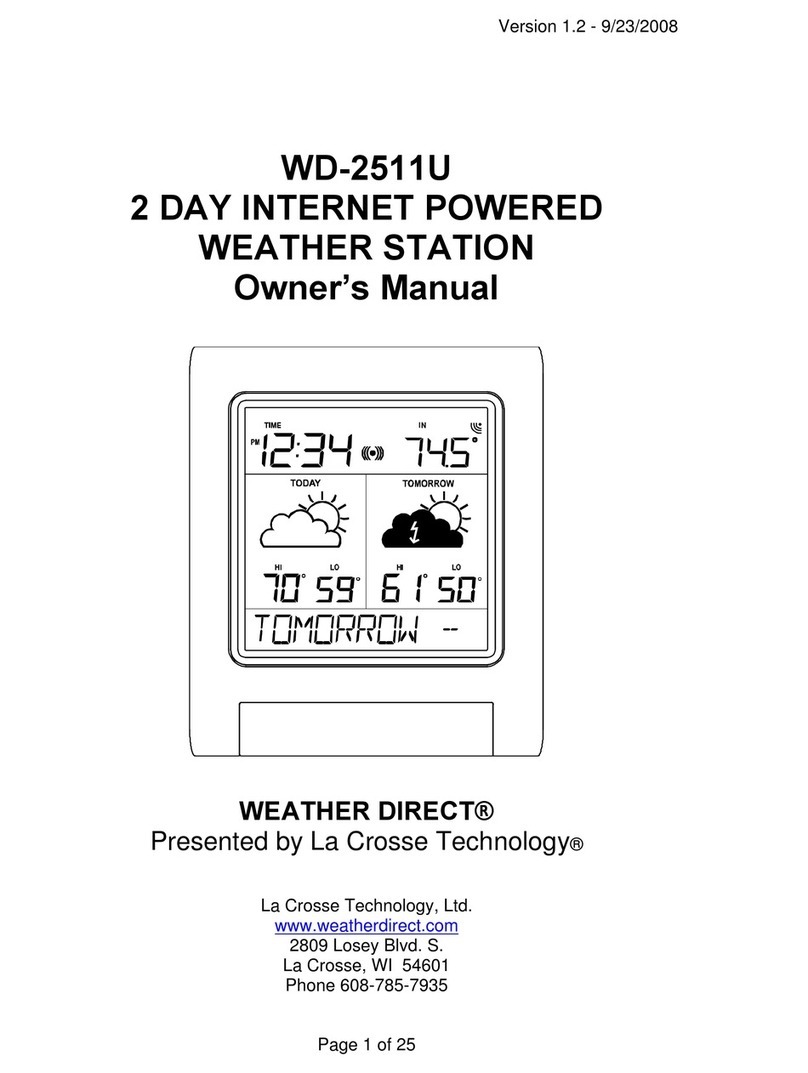
WEATHER DIRECT
WEATHER DIRECT Internet-Powered Weather Station WD-2511U owner's manual
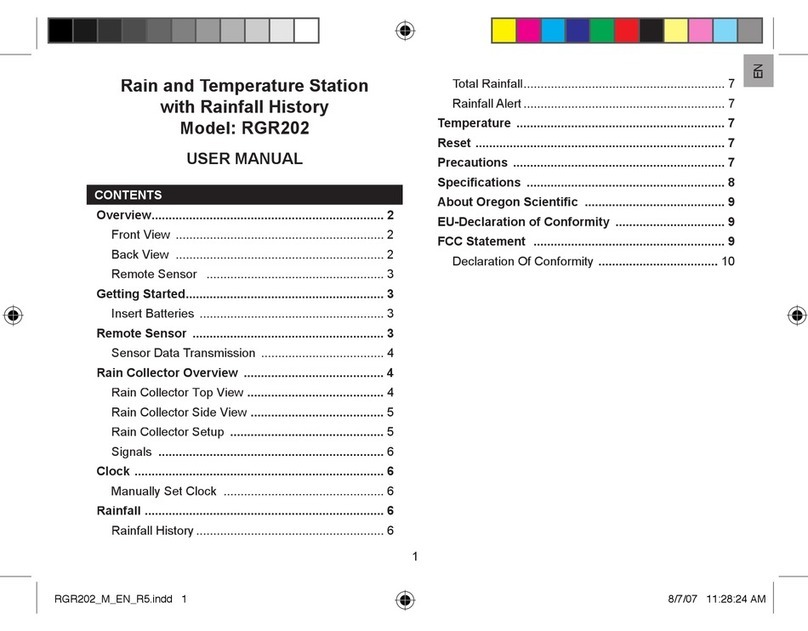
Oregon Scientific
Oregon Scientific RGR202 user manual
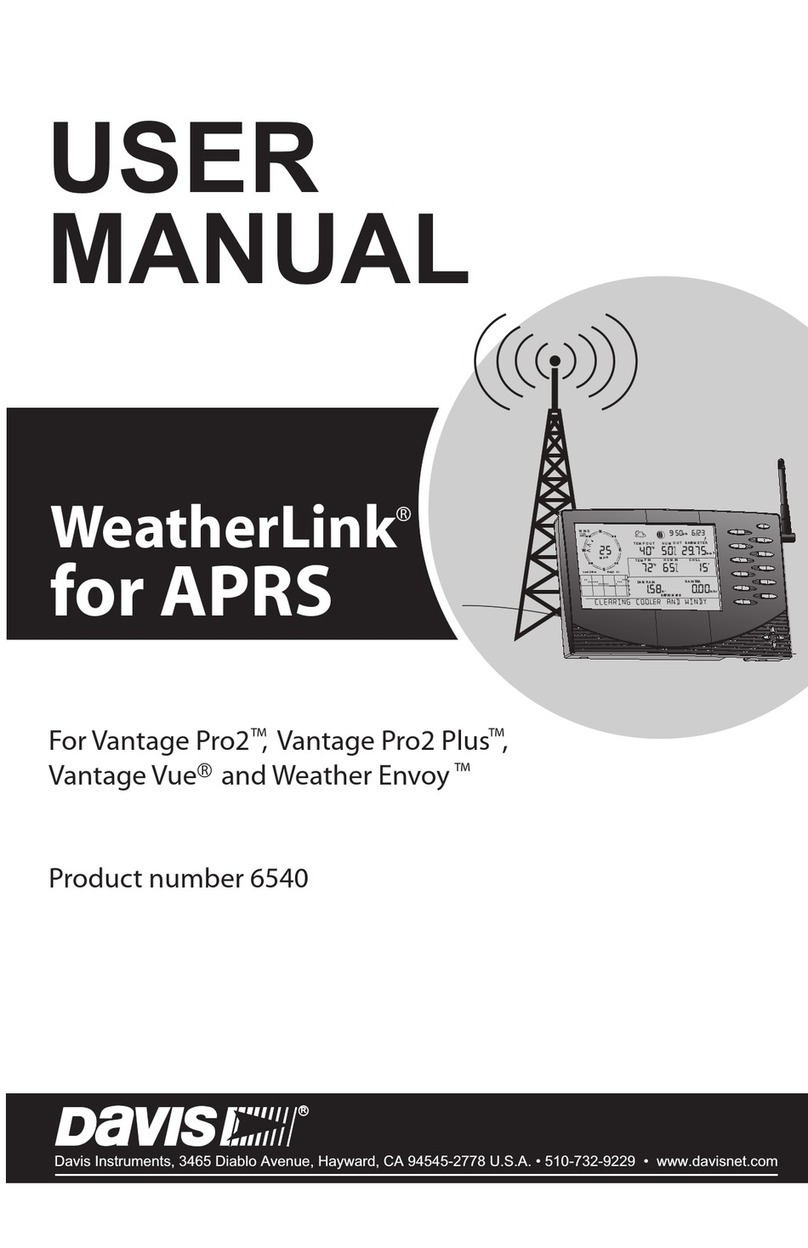
DAVIS
DAVIS WeatherLink 6540 user manual
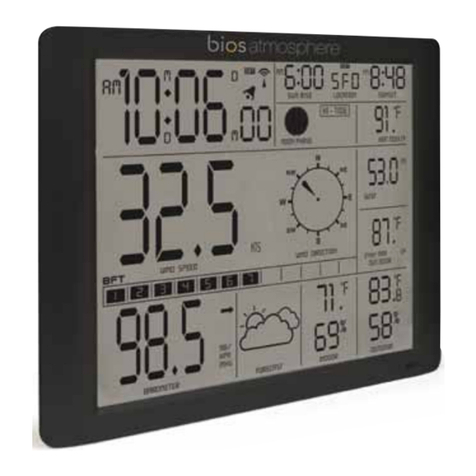
Thermor
Thermor bios atmosphere 2.0 instruction manual
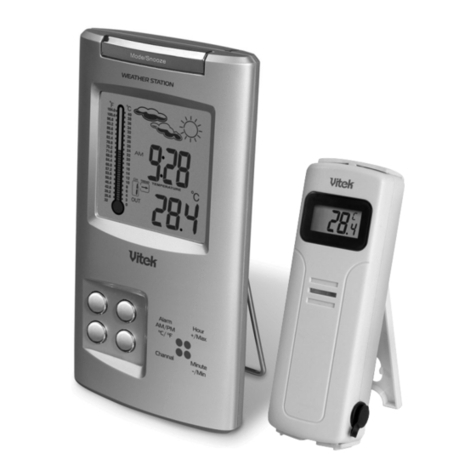
Vitek
Vitek VT-3539 instruction manual

